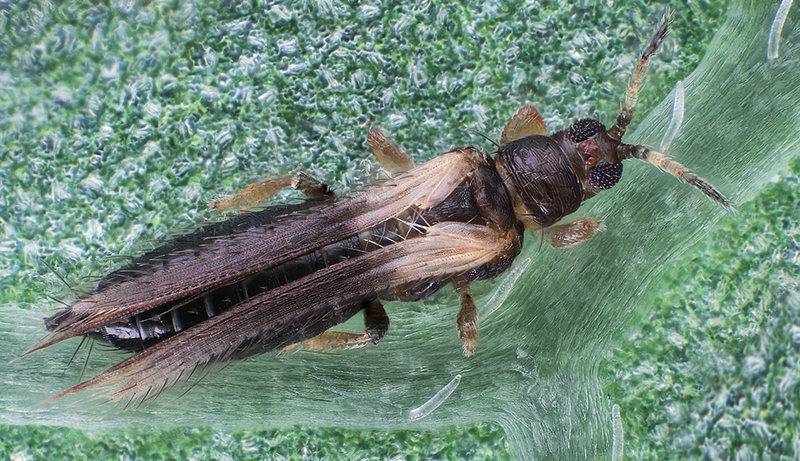
Thrips
Frankliniella Spp.
Pathogen:
Insect
Type:
Risk:
HIGH




DESCRIPTION
Pathogen description
Frankliniella spp. They are a group of small insects belonging to the family Thripidae, commonly known as thrips. These insects have a holometabolous life cycle, which includes the egg, larva, prepupa, pupa and adult stages. Adult females lay eggs in plant tissue, and these hatch into larvae that feed on plant cells. After several molts, the larvae move on to the prepupal and pupal stages, which generally occur in soil or decaying plant material. Eventually, they emerge as adults capable of flying and dispersing to new host plants. This life cycle can be completed in as little as two weeks under optimal temperature and humidity conditions. Thrips are known for their high reproduction rate and their ability to cause significant damage to a wide variety of plants.
Disease description
The disease known as thrips, caused by Frankliniella spp., affects blackberries and is characterized by the appearance of several visible symptoms on the plant. Thrips feed on plant cells, causing direct and indirect damage. Direct damage is the result of the suction of cellular contents, while indirect damage comes from the transmission of phytopathogenic viruses. This results in reduced photosynthesis and plant growth, and can lead to a significant decrease in fruit yield and quality.
- Deformations in leaves and fruits.
- Silver Taches or discolorations on the leaves.
- Presence of black dots that are the excrement of thrips.
- Premature fall of flowers and fruits.
- Delay in the growth of young plants.
- Appearance of scarred or corky tissues in the fruits.

TEMPERATURE AND HUMIDITY
20°C a 30°C
60% a 80%

VOIES DE TRANSMISSION
Wind, Infested plants, Contaminated tools, Transport of fruits and flowers, Field personnel

Chemical treatments
CONTROL
• RAPE OIL 1.53% [AL] P/V
• RAPE OIL 848.24 g/l [EC] P/V
• ORANGE OIL 60g/L [ME] P/S
• PARAFFIN OIL (CAS [8042-47-5]) 54.6% [EW] P/V
• AZADIRACTIN 1% (AS AZADIRACTIN A) [EC] P/V
• Azadirachtin 2.6% (AS AZADIRACTIN A) [EC] P/V
• FORMETANATE 50% [SP] P/P
• PYRETHRINS 4.65% (as pyrethrum extract) [EC] P/V
• POTASSIUM SALTS OF FATTY ACIDS C14-C20 48% [EW] P/V
• SPINOSAD 48% [SC] P/V
• ADHESIVE TRAP
• CHROMATIC TRAP
Treatments authorized in organic farming
• RAPE OIL 1.53% [AL] P/V
• RAPE OIL 848.24 g/l [EC] P/V
• ORANGE OIL 60g/L [ME] P/S
• PARAFFIN OIL (CAS [8042-47-5]) 54.6% [EW] P/V
• AZADIRACTIN 1% (AS AZADIRACTIN A) [EC] P/V
• Azadirachtin 2.6% (AS AZADIRACTIN A) [EC] P/V
• PYRETHRINS 4.65% (as pyrethrum extract) [EC] P/V
• POTASSIUM SALTS OF FATTY ACIDS C14-C20 48% [EW] P/V
• SPINOSAD 48% [SC] P/V
• ADHESIVE TRAP
• CHROMATIC TRAP
Biological control
• AMBLYDROMALUS LIMONICUS (Parasitoid and predatory mites)
• AMBLYSEIUS SWIRSKII (Parasitoid and predatory mites)
• BEAUVERIA BASSIANA (STRAIN ATCC 74040) 2.3% (2.3X10E7 VIABLE SPORES/ML) [OD] P/V
• BEAUVERIA BASSIANA (GHA STRAIN) 22% (4.4 x 10E10 CONIDIAS/G) [WP] P/P
• CHRYSOPERLA CARNEA (Parasitoid and predatory insects)
• HETERORHABDITIS BACTERIOPHORA (Parasitoid and predatory nematodes)
• MACROCHELES ROBUSTULUS (Parasitoid and predatory mites)
• MACROLOPHUS PYGMAEUS (Parasitoid and predatory insects)
• METARHIZIUM BRUNNEUM strain Ma 43 10.5% [OD] P/V
• NEOSEIULUS CUCUMERIS (Parasitoid and predatory mites)
• ORIUS LAEVIGATUS (Parasitoid and predatory insects)
• PAECILOMYCES FUMOSOROSEUS (STRAIN FE 9901) 18% (2 X 10 E9 CFU/G) [WP] P/P
• STEINERNEMA FELTIAE (Parasitoid and predatory nematodes)
• TRANSEIUS MONTDORIENSIS (Parasitoid and predatory mites)
Preventive treatments
• BEAUVERIA BASSIANA (STRAIN ATCC 74040) 2.3% (2.3X10E7 VIABLE SPORES/ML) [OD] P/V
• BEAUVERIA BASSIANA (GHA STRAIN) 22% (4.4 x 10E10 CONIDIAS/G) [WP] P/P
• ADHESIVE TRAP
• CHROMATIC TRAP
- Implement regular monitoring practices for early detection of the presence of thrips in blackberry crops.
- Use blue or yellow sticky traps to capture adults and reduce the population.
- Maintain good crop hygiene, eliminating plant remains and weeds that could serve as a refuge for thrips.
- Promote the use of natural enemies, such as predatory mites and lacewings, for biological control.
- Apply insecticides in a rotating manner to avoid the development of resistance, following technical recommendations.
- Use plant covers and mulches to hinder the migration of larvae to the soil and their subsequent development.
- Avoid excessive use of nitrogen fertilizers, as they can favor the growth of thrips populations.
- Implement integrated pest management (IPM) measures combining cultural, biological and chemical techniques.
Recommendations
*The recommended treatments are recommendations based on the authorities' databases and do not replace in any way the guidelines established by the legislation of each country.





